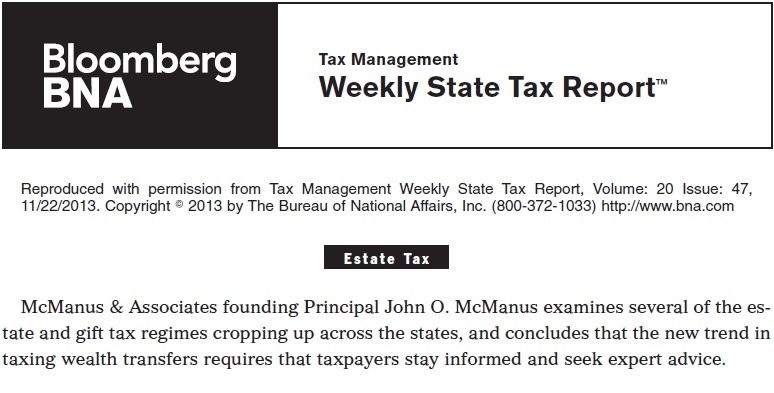The below article written by John O. McManus appeared in “Practical Tax Strategies,” published by Thomson Reuters, in the April 2013 issue (Volume 90, Number 4, pg. 172- 174).
VACATION PROPERTY: PRESERVING THE FAMILY RETREAT
There are advantages and disadvantages to using a second residence as a funding source for a trust.
JOHN O. MCMANUS, J.D., is the founding principal of the trusts and estates law firm McManus & Associates in New York, NY.
Amidst ongoing uncertainty over America’s economic future and about which financial strategies will be effective in the long-run, many Americans are focused on ensuring that one of their most treasured assets— the mountain house, lake house or beach house—is able to be appreciated for years to come. The family retreat often holds rich memories, serves as a spot for loved ones to still gather, and is a place that the owner hopes children and grandchildren will continue to enjoy. After working hard, finding success, building net worth, and employing the gift of a second residence for the benefit of family, how can one protect both the asset and his or her intentions for it over the long-term?
Thanks to the fiscal cliff deal, the opportunity to take advantage of the $5 million gift tax exemption to transfer real estate, businesses, private equity ownership, stock portfolios, and cash out of one’s name and into trust for the benefit of loved ones has been extended for the foreseeable future. Strictly from a financial standpoint, is real estate the best asset to transfer?
When considering one’s second residence as a funding source for a trust, there are advantages and disadvantages that should be weighed. In some instances, the optimal discounted value may not be attainable, but since real estate is often discounted organically (the value decreases with age) due to market forces, if the property is not renovated, it may present the best financial and emotional option. Those seeking to transfer real estate in a tax-efficient manner should think through several strategies.
Joint tenants with rights of survivorship
Joint tenants with rights of survivorship is the typical ownership between husband and wife, and it affords valuable protections. Property is automatically inherited by and passes by operation of law to a surviving spouse, avoiding the probate process. When one spouse passes away, tax benefits also can be achieved by filing estate tax returns.
Joint tenancy also helps to protect the property from a creditor of one spouse. A home can quickly become an asset at risk if there is a financial reversal of one spouse. Creditors taking over an asset will often want to sell it to a third party, but no buyer wants to own a property in joint names with an independent party. If the purchaser of the property were to pass away, the independent party would inherit their interest, leaving no real value.
Limited liability companies
Limited liability companies (LLCs) offer anonymity and tax planning advantages. Having an LLC as the owner on a property deed can protect one’s identity in many states, but a notable exception is in Arizona where greater than 20% owners must be registered. Additionally, if there is an accident on the property and it extends beyond property and casualty insurance coverage, only the assets in the LLC would be at risk.
Ownership of a second residence can be transferred to an LLC or into two LLCs; one spouse owns the LLC or two LLCs can be set up with each spouse owning one. Having the property in only one spouse’s name means the LLC is considered a disregarded entity and avoids the need to file tax returns every year.
Revocable living trust
A revocable living trust, or a family trust, is established while one is still living. One can make changes at any time, as well as reclaim the property transferred into it. The trust also outlines how the trust property should be managed while the grantor is still alive and how it should be distributed upon the grantor’s death, providing for a succession of authority to manage the residence in trust.
For the many Americans that have property in other states, putting a residence into a revocable trust allows them to minimize probate and eliminate it with respect to the state where they have only a residence (the probate process takes place in the state where the resident lives and where the property is located). Florida, for example, has no income tax, but the state is heavy on probate fees. A revocable living trust is not intended to take a property outside of the taxable estate. For example, it is essential that owners who work in, but live outside of, New York consider putting properties located in New York into trust—giving up control of the property in name—to avoid the income tax on non-New York residents. If an individual works in New York more than 183 days and owns a property in the state—irrespective of if he or she uses it—it is presumed a residence and the state of New York calls the individual a resident, requiring him or her to pay New York income tax.
Qualified personal residence trust
A qualified personal residence trust (QPRT) puts a personal residence in trust for the benefit of one’s spouse and children (or for a charity) and offers great discounts. The trust is created and controlled by the homeowner-grantor, although the property title is transferred to the QPRT. The way the QPRT is structured allows the value of the asset in trust to shrink. This was especially useful when the estate and gift tax exemption amount was $1 million because one cannot give away assets over the maximum exemption amount without paying gift tax. For the balance of 2013, the exemption is $5 million per person and will be adjusted for inflation in future years.
For some clients, this higher exemption amount has removed the need to put the asset in a QPRT to get the discount and shrink the asset for gift tax purposes. Some people say money is cheap with interest rates so low and like the idea of keeping a mortgage on a property. With a QPRT, having a mortgage is not advised, but there is opportunity to gain future appreciation, not just today’s discount. Putting the family retreat into a QPRT allows one to enjoy the right to live in it and maintain control. There is a “mortality risk” with this type of trust, however; if one dies before the trust terms end (10 to 15 years on average), the asset gets clawed back into the estate and is subject to taxation.
How can one hedge his or her bets? Divide the second residence into two deeds and two QPRTs with different spouses and terms, and only half of the asset will be sucked back into the estate if one spouse dies. This is particularly useful when there is great age disparity and different life expectancies for each spouse, because one person can have a longer term on one of the QPRTs.
It should be noted that if the second residence is removed from the QPRT, it must be replaced with an asset of equal value. If one is 60 years old, has a $2 million house and creates a 20-year QPRT, the discount today is approximately $700,000; the grantor, however, must live for the next 20 years. Saving $700,000 in value could save $350,000 to $400,000 in estate tax and significantly more as the property appreciates. In order to sell, however, the asset must be replaced with one of equal value or a separate trust must be created for the shortfall on the proceeds. For example, selling a $2 million house that has increased in value to $3 million and then buying a $2.5 million house would leave an excess of $500,000 that must go into a separate trust.
Lifetime credit shelter trust
A lifetime credit shelter trust (LCST) is an irrevocable trust for the benefit of one’s spouse, children, and grandchildren. Unlike with a QPRT, LCSTs do not allow discounts beyond market discounts, but there is much more flexibility than with the QPRT. There is no trust term that the grantor must outlive, and if one decides to sell real property that is in a LCST, it does not have to be replaced with real property (if the residence in a QPRT is sold during the term of the trust, the funds need to be used to purchase another residence, or there are negative tax consequences).
If one gives the family retreat away via trust to a spouse, he or she still has access to the property. It is, however, necessary for the donor of the trust to create a lease with his or her spouse and children for an amount of their fractional use of the property that correlates with expenses for things like maintenance. There is a built-in depreciation in using this strategy, because real estate is currently valued low.
After the parents pass away, lifetime trusts offer asset protection for children in their marriages. In the event of a divorce, the child’s spouse is not entitled to any of the assets in trust. Otherwise, the home may be at risk when given to one’s child in common with siblings who may have to give a disproportionate amount of other assets to the divorcing child’s spouse in order to keep the family retreat. The exemption from generation-skipping transfer tax is also worth the effort with LCSTs, because the trust will pass tax-free to grandchildren upon the death of the children. To protect from creditors, divorce situations, and plaintiffs’ lawyers, the asset should remain in trust for children, either with a trust for each child as trustee or with a pod trust, which assures a governing board to help manage the asset, avoiding the perils of revolution and insurrection within the family. If children have different goals for the property, it may be necessary for one child to buy out the other—or, if all of the children are in agreement, they can sell the home and invest the proceeds in a different asset.
Other strategies and concerns
What strategies should be considered if there is a worry about who will pay the bills to fund the expenses of a second residence? Renting a residence out allows for an income stream to pay for such costs. Funding a trust with life insurance also allows the policy payout to provide liquidity to cover expenses. Having the family home preserved in trust for generations provides a plan to minimize the burden of expenses and maintenance on the children to achieve the goal of creating generations of happy family members at the retreat.
A family mission statement for a vacation residence also has a positive impact on family dynamics. It helps to manage expectations, such as who gets to enjoy the home when. Often a family member will leave guests at the retreat a letter telling them where all household items can be found. The family mission takes this notion to the next level.
Finally, it is critical to confirm that all deeds have been retitled, tax forms filed, and lease agreements executed. These steps are extremely important, because if they are not completed, the IRS will not acknowledge the formality of the trust, and the tax exemption that the trust structure was intended to provide would be lost. Not only must the trust be created, but the deeds must be transferred into the trust immediately afterwards. One’s property and casualty insurance carrier should also be notified when ownership of the property is transferred to the trust. Giving away a home into trust often creates diverging insurable interests due to ownership of valuables like artwork and furniture in the home. Carriers need to understand one’s insurance structure and should be informed when there are two separate carriers for the home and assets within it. Executing a lease agreement ensures protection of ownership in the house once it has been given away and guards against trustees deciding they want to sell it.
Conclusion
Using real estate as a funding source when considering the opportunity to leverage the flexibility to transfer assets extended by the fiscal cliff deal could be not only the logical choice, but the sentimental one. By putting the family retreat into trust, one can create greater assurances that this cherished gathering place, or even a successor home, will remain in the family for many generations to enjoy.




 ⟩
⟩ ⟩
⟩ ⟩
⟩ ⟩
⟩ ⟩
⟩ ⟩
⟩